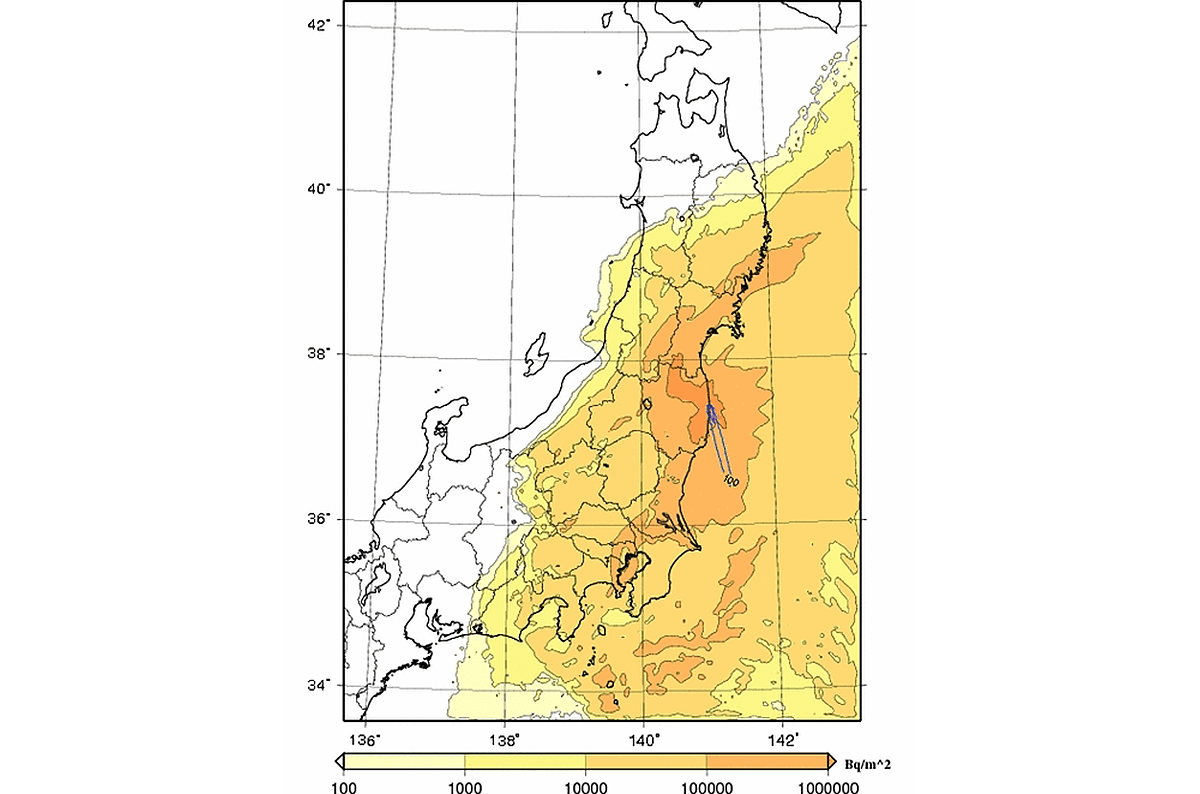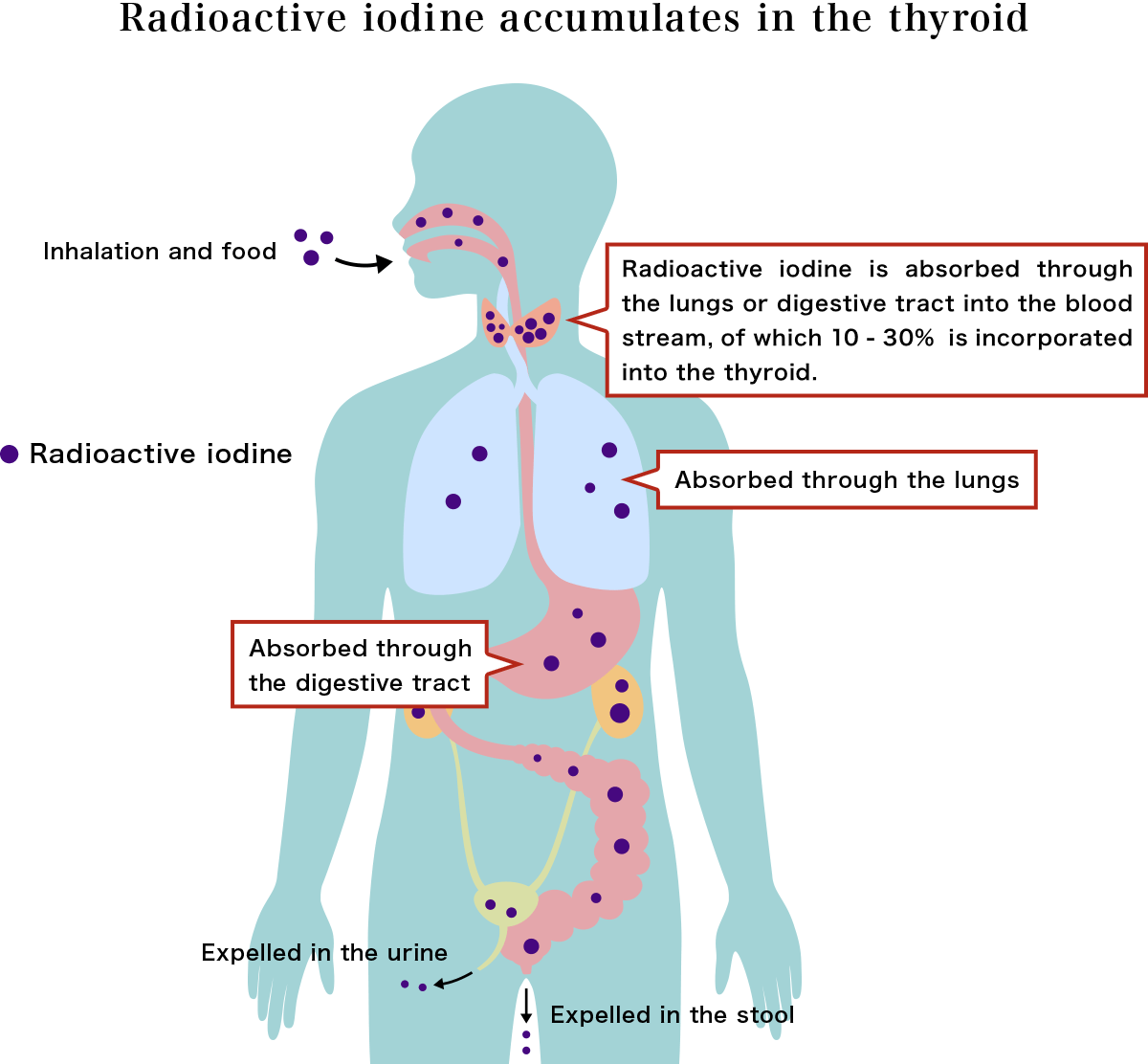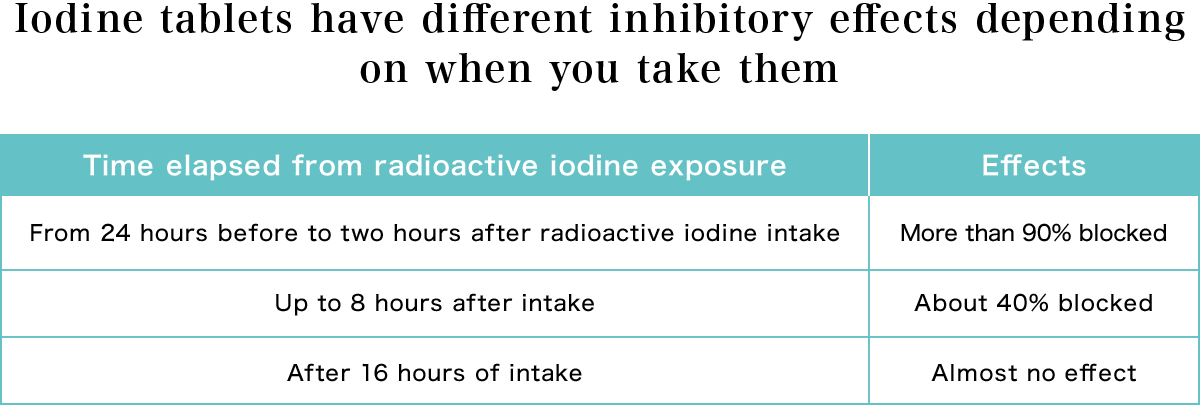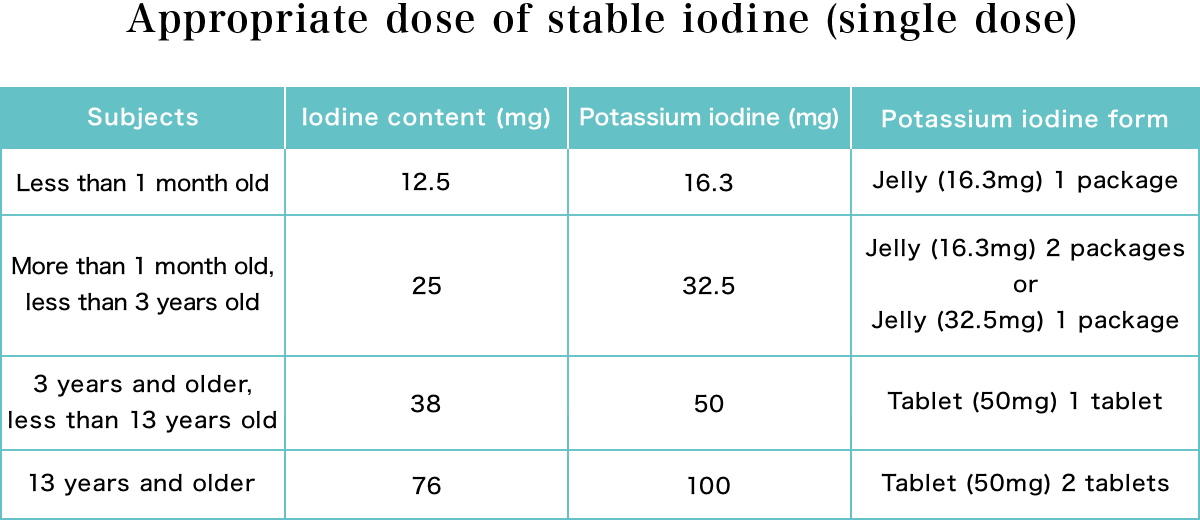The Nuclear Power Plant Accident
and Thyroid Cancer
目次
- Why did people worry about thyroid cancer after the Fukushima Nuclear Power Plant Accident?
- Why should people take iodine tablets (“stable iodine,” “potassium iodide”) in the event of a nuclear accident?
- When should iodine tablets be taken? What is the required dosage?
- Did the people of Fukushima Prefecture take iodine tablets?
1. Why did people worry about thyroid cancer after the Fukushima Nuclear Power Plant Accident?

A large quantity of radioactive iodine was released during the Chernobyl Nuclear Power Plant accident in 1986, and not long after, there was a sudden increase in childhood thyroid cancer in the contaminated areas. It was confirmed that radioactive iodine was the cause of the thyroid cancer. As shown in the above figure, radioactive materials, including radioactive iodine, were widely dispersed during the TEPCO Nuclear Power Plant Accident, and the residents of the area were concerned about thyroid cancer. According to the plan laid out by the former Nuclear Safety Commission, the government should have distributed iodine tablets and instructed people to take them in order to prevent damage from radioactive iodine.
2. Why should people take iodine tablets (“stable iodine,” “potassium iodide”) in the event of a nuclear accident?
When radioactive iodine enters the body through the lungs or with food, it accumulates in the thyroid gland via the bloodstream. It then irradiates the cells from inside the thyroid gland, which can result in cancer.

The thyroid gland synthesizes thyroid hormones, which are necessary for the growth and function of every organ in the body and for metabolism. The thyroid gland takes in iodine from the blood, since iodine is an essential material for the synthesis of thyroid hormones. Radioactive iodine and non-radioactive iodine (“stable iodine,” “potassium iodide”) have the same chemical properties, so the thyroid gland takes in both. If the level of stable iodine in the bloodstream is sufficiently high, the chances of radioactive iodine being taken up by the thyroid gland are reduced. This is why it is important to take stable iodine before or directly after exposure to radiative iodine.
Most radiation specialists say that there is no cheaper medicine with fewer side effects than iodine tablets. If you have been diagnosed with iodine hypersensitivity, however, or have a thyroid disorder, you may want to consult with your physician about other countermeasures.
3. When should iodine tablets be taken? What is the required dosage?
If you take iodine tablets prior to or two hours after radioactive iodine intake, it can inhibit more than 90% of the uptake. The effect decreases with the passage of time following ingestion of the radioactive iodine (see table below). Therefore, it is better to take iodine tablets as soon as you know there has been an accident. In fact, it is advisable to keep stable iodine on hand. It can be obtained with the help of a doctor.

The appropriate dose of stable iodine is age dependent.

Since fetuses, infants and minors are most vulnerable to the effects of radioactive iodine, pregnant women, nursing mothers and minors should be instructed to take stable iodine if an accident occurs. Learning from the TEPCO accident, the government decided to distribute stable iodine tablets in advance to households within 5km of all plants in Japan. Only one dose per person has been distributed, however, and since the effect of stable iodine lasts for just 24 hours, more tablets should be made available. The current guidance is that if evacuation is not possible, 24 hours after the first dose, the chair of the Nuclear Regulation Authority will give additional instructions as to what residents should do. It is possible, however, that the chair may not issue any instructions, or those instructions may not reach people in the affected area.
Evacuation routes have been set up in advance from areas within the 30km range from each power plant in Japan. The decision has been made to stockpile stable iodine at public facilities along the routes.
It is doubtful, however, that these measures will be adequate, given that the Fukushima accident contaminated areas beyond 30 km from the plant, such as Iitate Village, most of which is 30-40km from the plant.
4. Did the people of Fukushima Prefecture take iodine tablets?
Before the accident, the municipalities where the plant is located had conducted emergency drills in preparation for an accident. At the time of the accident, the authorities were supposed to predict how much and in which direction the radioactive plume would go, determine the direction of evacuation, and instruct people to take iodine tablets if it was estimated that the radiation dose to the thyroid gland would reach 100 millisieverts (13,000cpm).
The predictions were fairly accurate, but neither the prefectural nor the national government informed the residents of the direction of the plume, so many residents evacuated to the area where the radioactive plume was actually flowing. There were some people whose exposure exceeded the standard for taking iodine tablets, but the prefectural government did not distribute iodine or instruct them to take iodine, even though they had sufficient stockpiles. Only three townships – Miharu, Futaba and Tomioka – issued their own instructions. Overall, only about 10,000 people took iodine tablets.
Further information about radioactive iodine and iodine products
- The time needed for radioactive iodine (iodine-131) to be reduced to half its original level (half-life) is 8 days, so in 80 days it should be reduced to 1/1000th of its initial level. Today, 10 years after the accident, there is no more radioactive iodine-131 left from the accident.
- Although the side effects of iodine tablets were at first exaggerated by the former Nuclear Safety Commission, the Nuclear Regulation Authority now urges us to be aware that the risk of damage to the thyroid from not taking iodine is greater than the risk of side effects.
- Those over 40 years of age were told they did not need to take iodine tablets. The reasoning was based on research suggesting there was no increase in thyroid cancer among adult A-bomb survivors, and that the increase in thyroid cancer after the Chernobyl accident occurred only in those under the age of 18. Recently, however, there has been an increasing number of reports showing a rise in the number of radiogenic cancers in people over the age of 40, so the view that those over 40 do not need to take iodine tablets should be revised.
- cpm (count per minute) : The number of rays (beta or gamma rays) that pass through the detector of a Geiger counter in one minute. 100 cpm is equal to 100 rays per minute.
Created: March 2021
-
Dose Dependency and the Mechanism of Carcinogenesis
-
The Nuclear Power Plant Accident and Thyroid Cancer
- Why did people worry about thyroid cancer after the Fukushima Nuclear Power Plant Accident?
- Why should people take iodine tablets (“stable iodine,” “potassium iodide”) in the event of a nuclear accident?
- When should iodine tablets be taken? What is the required dosage?
- Did the people of Fukushima Prefecture take iodine tablets?
-
Thyroid Examinations in Fukushima Prefecture after the TEPCO Nuclear Accident
- The thyroid examination system in Fukushima Prefecture.
- The high incidence of thyroid cancer in Fukushima Prefecture.
- Is there an association between the level of contamination and thyroid cancer incidence?
- An accurate thyroid cancer case count is essential.
- The decline in thyroid screening rate is a problem.
-
What Can We Do to Protect Children’s Health?

